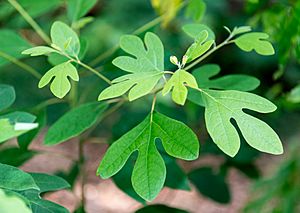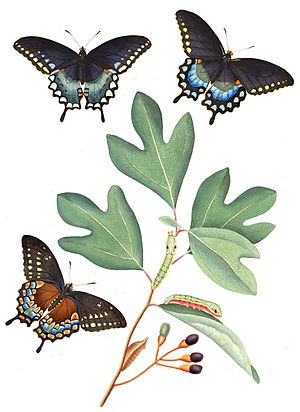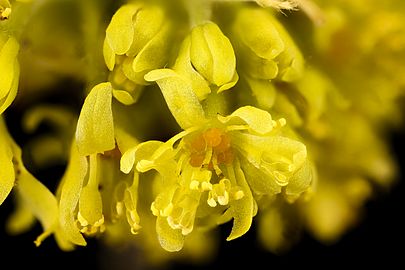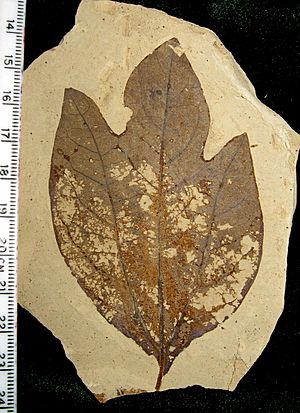Sassafras facts for kids
Quick facts for kids Sassafras |
|
|---|---|
 |
|
| Sassafras albidum, Norfolk Botanical Garden |
|
| Scientific classification |
|
| Kingdom: | Plantae |
| Clade: | Tracheophytes |
| Clade: | Angiosperms |
| Clade: | Magnoliids |
| Order: | Laurales |
| Family: | Lauraceae |
| Genus: | Sassafras J.Presl |
| Species | |
|
Sassafras albidum |
|
| Synonyms | |
|
Pseudosassafras Lecomte |
|
Sassafras is a group of trees known for their amazing smell! There are three types of sassafras trees alive today and one type that is now extinct. These trees are found naturally in eastern North America and eastern Asia. Sassafras trees are special because almost all parts of them have a nice, spicy scent. This smell has made them very useful to people for a long time.
Contents
What Sassafras Trees Look Like
Sassafras trees can grow quite tall, from about 30 to 115 feet high. They have many thin branches and smooth bark that can be orange-brown or yellow. Every part of a sassafras tree, from its roots to its leaves, smells good!
One of the coolest things about sassafras trees is their leaves. On the same tree, you can find three different leaf shapes:
- Oval (like an egg)
- Mitten-shaped (with two lobes, like a thumb and fingers)
- Three-pronged (with three lobes)
Sometimes, you might even see leaves with five lobes, but that's rare. The young leaves and twigs feel a bit slimy (this is called mucilaginous) and smell like citrus when you crush them.
The flowers are tiny and yellow, usually with six petals. Some sassafras trees have male and female flowers on separate trees. Other types have both male and female flowers on the same tree. After the flowers, the tree grows dark blue-black fruits that look like small berries.
The biggest known sassafras tree in the world is in Owensboro, Kentucky. It's over 100 feet tall and its trunk is about 21 feet around!
Naming Sassafras
The name "sassafras" was first used by a botanist named Nicolas Monardes in 1569. Some people think the name comes from a Latin word meaning "stone-breaking." This is because some plants with similar names were thought to help with kidney stones.
Long ago, Native Americans had their own names for this plant. In some areas, they called it winauk or pauane. They even had different names for "white sassafras" and "red sassafras," which were different parts of the same plant used for different things. In Germany, it was known as "fennel wood" because of its unique smell.
Types of Sassafras Trees
There are four known types of sassafras trees. Three of them are still alive today, and one is only known from fossils. These trees grow naturally in two main areas: North America and East Asia.
North American Sassafras
- Sassafras albidum: This is the most common type in eastern North America. You can find it from southern Canada all the way down to central Florida and west to Iowa and East Texas. It's also called white sassafras or red sassafras.
- †Sassafras hesperia: This type is extinct. We only know about it from fossils found in western North America, like in Washington state.
East Asian Sassafras
- Sassafras tzumu: This type is also called Chinese sassafras. It grows in central and southwestern China.
- Sassafras randaiense: This sassafras tree is native to Taiwan.
Where Sassafras Trees Grow
Most trees in the laurel family (which sassafras belongs to) are evergreen and like lots of rain. But sassafras trees are different because they are deciduous. This means they lose all their leaves for part of the year, usually when it's dry.
Sassafras trees often grow in open forests, along fences, or in fields. They like moist, well-drained soil, but they can grow in many different soil types. They grow best in warmer, wetter areas.
Sassafras albidum is found across a wide area in North America. The Chinese sassafras (S. tzumu) grows in many provinces in China. The Taiwanese sassafras (S. randaiense) is found only in Taiwan.
Sassafras and Wildlife
Many animals eat parts of sassafras trees, but usually in small amounts.
- White-tailed deer and porcupines eat the leaves and twigs.
- Other animals like groundhogs, marsh rabbits, and black bears also munch on the leaves.
- Rabbits eat the bark in winter.
- Beavers will cut down sassafras stems.
The fruits of sassafras trees are a favorite food for many birds, including quail, eastern kingbirds, wild turkeys, and many types of thrushes and woodpeckers. Some small mammals also eat the fruits.

Important Safety Note
Sassafras oil contains a substance called safrole. Studies have shown that safrole might cause health problems in animals. Because of this, sassafras oil is not allowed in commercially made foods and medicines in the United States.
How People Use Sassafras
People have used sassafras trees for many things over hundreds of years. This includes their roots, stems, leaves, bark, flowers, and fruits. They've been used for cooking, medicine, and their pleasant smell. The wood has also been used to build ships and furniture. Sassafras even played a big part in the early history of Europeans coming to America! Sassafras twigs were even used as early toothbrushes and to start fires.
Cooking with Sassafras
Sassafras albidum is a key ingredient in some special foods in the United States.
- It was the main flavor in traditional root beer and sassafras root tea.
- Ground sassafras leaves are used in Louisiana Creole cuisine. They are a special ingredient in filé powder, which helps thicken and flavor dishes like gumbo.
However, since 1960, sassafras oil has been banned from commercially made foods and drugs in the US. This is because of the health concerns about safrole.
Besides these uses, sassafras leaves and flowers have been added to salads. They were also used to flavor fats or to cure meats. Young sassafras twigs can be eaten fresh or dried. You can also peel, dry, and boil the underground parts of the plant to make tea.
Traditional Medicine Uses
Many Native American tribes used sassafras leaves to treat wounds by rubbing them directly on the injury. They also used different parts of the plant for many other health issues, like acne, urinary problems, and fevers. In East Asia, types of sassafras like S. tzumu are used in Chinese medicine to help with rheumatism (joint pain) and injuries.
Some modern research suggests that sassafras oil, roots, and bark might help with pain and act as a disinfectant. Different parts of the sassafras plant have been used to treat problems like scurvy, skin sores, kidney issues, toothaches, swelling, and high blood pressure. It was also used as a fungicide (to kill fungus) and for its scent.
Sassafras root was one of the first things exported from North America back in 1609. Sassafras wood and oil were also used in dentistry. Early toothbrushes were made from sassafras twigs because of their nice smell. Sassafras was also used as an early pain reliever and cleaner for teeth.
Sassafras Wood
Sassafras albidum is often planted as a decorative tree because of its unique leaves and pleasant smell. Its strong and beautiful wood has been used to build ships and make furniture in North America, Asia, and Europe. Native Americans in the southeastern United States also used sassafras wood to start fires because of the natural oils in the wood and leaves, which make it easy to burn.
Sassafras Oil and Scent
When the dried root bark of sassafras is steamed, it produces an essential oil. This oil has a lot of safrole in it, along with other chemicals like camphor. Sassafras oil was once widely used as a scent in perfumes, soaps, and even for aromatherapy.
Sassafras oil has also been used as a natural way to keep insects or pests away. It was added to some drinks to hide strong or unpleasant smells. It was also put into soaps and other personal care products. However, as mentioned, the FDA in the United States has banned its use in commercially made foods and drugs because it might cause cancer.
Commercial Uses Today
Today, sassafras plants are grown and harvested mainly for their oil. This oil is used in various commercial products. For example, it's used to make a compound called piperonyl butoxide, which helps insecticides work better. These plants are mostly harvested for commercial use in Asia and Brazil.
See also
 In Spanish: Sasafrás para niños
In Spanish: Sasafrás para niños




